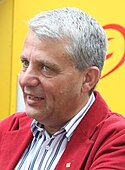Norwegian parliamentary election, 2009
|
|
||||||||||||||||||||||||||||||||||||||||||||||||||||||||||||||||||||||||||||||||||||||||||||||||||||||||||||
|---|---|---|---|---|---|---|---|---|---|---|---|---|---|---|---|---|---|---|---|---|---|---|---|---|---|---|---|---|---|---|---|---|---|---|---|---|---|---|---|---|---|---|---|---|---|---|---|---|---|---|---|---|---|---|---|---|---|---|---|---|---|---|---|---|---|---|---|---|---|---|---|---|---|---|---|---|---|---|---|---|---|---|---|---|---|---|---|---|---|---|---|---|---|---|---|---|---|---|---|---|---|---|---|---|---|---|---|---|
|
||||||||||||||||||||||||||||||||||||||||||||||||||||||||||||||||||||||||||||||||||||||||||||||||||||||||||||
|
|
||||||||||||||||||||||||||||||||||||||||||||||||||||||||||||||||||||||||||||||||||||||||||||||||||||||||||||
|
All 169 seats to the Norwegian Parliament 85 seats were needed for a majority |
||||||||||||||||||||||||||||||||||||||||||||||||||||||||||||||||||||||||||||||||||||||||||||||||||||||||||||
|
||||||||||||||||||||||||||||||||||||||||||||||||||||||||||||||||||||||||||||||||||||||||||||||||||||||||||||
|
||||||||||||||||||||||||||||||||||||||||||||||||||||||||||||||||||||||||||||||||||||||||||||||||||||||||||||
The 2009 parliamentary election was held in Norway on 13 and 14 September 2009. Elections in Norway are held on a Monday in September, usually the second or third Monday, as determined by the king. Early voting was possible between 10 August and 11 September 2009, while some municipalities also held open voting on 13 September. Voters elected 169 members for the Storting, each for a four-year term. Voter turn-out in the 2009 general elections was 76.4%.
Candidates were elected on party lists in each of the 19 counties. The political parties nominated candidates for these lists during late 2008 and early 2009. The party lists had to be registered by 31 March 2009.
Although the opposition received more votes, the governing Red-Green Coalition obtained more seats in parliament. This allowed Jens Stoltenberg to continue as prime minister. Further to the right, both the Conservative Party and Progress Party increased their number of seats in parliament. The centrist Liberal Party failed to meet the electoral threshold of 4.0%, and were reduced to two representatives in Parliament.
There are 169 seats in the Norwegian Parliament, but voters directly elect only 150 as constituency representatives, while the remaining 19 are "at-large" members—one for each county—and these are apportioned to parties based on the total national vote.
For the purposes of parliamentary elections, Norway is divided into 19 constituencies corresponding to the counties, including the municipal authority of Oslo, which is a county of its own. The number of members to be returned from each constituency varies from 3 to 16, according to the population and area of the county. Norway has capped the number of "fixed" seats at 150 and, to determine how to apportion those amongst the 19 counties, it uses a two-tier formula based on population and geographic size. Each inhabitant counts one point, while each square kilometer counts 1.8 points.
...
Wikipedia







